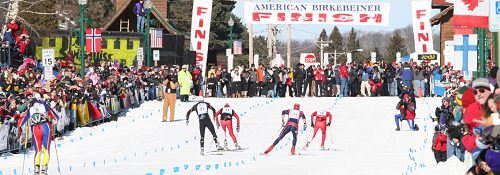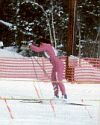Birkie Under the Gun
January 14, 2014
One of the new changes for the 2014 American Birkebeiner will be the return to the more traditional "gun timing" method.
A little background ...
Since the advent of chip timing, there have been two types of timing methods for calculating a participant's race time.
Chip Time - A timing device is placed near the start to record each participant's start time. A second timing device is placed at the finish line to record the end time. The participant's race time is then calculated by subtracting the individual start time from the individual finish time. With this system, every participant may have a different start time.
Gun Time - All participants in a race (or in a wave of a race) are given the same start time (for example, when a starting gun sounds). Each participant's time is then recorded at the finish line (usually using a timing chip worn by the skier). The participant's race time is then calculated by subtracting the race start time from the finish time when he or she crosses the line. With this system, every participant has the same start time (per wave).
The advantages to chip time is that participants can be at the back of a huge race field, standing still long after the start gun has sounded, but won't begin timing their race until they cross the actual start timing mat. It results in the most accurate timing of each participant's actual race distance.
The disadvantage to chip time is that it changes the race into more of a solo time trial, where you have no idea how you stand versus a participant you may be racing against but who started elsewhere in the field. A participant may sprint ahead of a number of competitors to the finish line, only to find out later than the chip time method gave them a faster result.
Neither system is perfect, and some races have tried to use a hybrid system where "elite" participants are timed by gun time while the rest of the field is timed by chip time. Even the hybrid systems can lead to confusion, as posted race times can differ from the actual order of finish.
Back to the Birkie

Bringing this back to the Birkie, a number of these points played into their decision to switch back to gun time for the 2014 event. [ To be clear, electronic timing chips will still be worn by the skiers and will continue be used to register the skier's race splits and finish time - only the way the start time is recorded changes. -- Ed ]
One of the issues leading to the change was the sizing of the timing mats for the start area. It wasn't possible to stretch timing mats the full length of the race field, so skiers were funneled into a narrow corridor just to cross the start mat. Moving to gun time eliminates a possible choke point surrounding the starting mat.
With chip time, a number of skiers began realizing there was no penalty for starting late, or even skipping your start wave. In fact, organizers reported skiers were staying in the corral after the wave had started, then proceeding out just a few minutes before next wave, or even possibly taking a front line position in the next wave. Ultimately, these skiers were impacting the later wave racers.
The chip time method also led to some confusing results. This can be seen in last year's results where the top six finishers in the Birkie Skate race were gun timed, then the rest were chip timed. The results show the seventh place finisher has a posted race time faster than the fifth and sixth skiers. Regardless of how many "elite" skiers are awarded a gun time, there would always be some chip timings that are faster than the gun timings.
Finally, the FIS/Worldloppet organization expressed a strong dissatisfaction with the gun/chip time hybrid system.
While the return to a gun time method may also bring the return of "panic" to some skiers, rushing to get to their start wave, on time, the American Birkebeiner Ski Foundation recognizes the issue and has put in place some measures that will hopefully alleviate some of the stress. First, they plan to start bussing 30 minutes earlier than in the past, in the hopes of getting skiers to the start area sooner. Second, they plan to have an additional and larger hospitality tent to provide a larger area for skiers to stay warm and "relax" before their race start, thus encouraging them to come to the start earlier (as well as offsetting the loss of Telemark Lodge).
Finally, the rumor that skiers will be disqualified if they miss their start is not true. Skiers who miss their start will still be timed using gun time (i.e. their start time will still be their wave start time). However, skiers that jump ahead, starting in an earlier start wave will be disqualified.
For those who really desire to retain a "chip time" of their race, perhaps the simplest solution is the oldest one - time yourself. By using your own wristwatch, you can even pause it for those "rest" stops along the way, giving yourself the most accurate race time possible! ;-)

